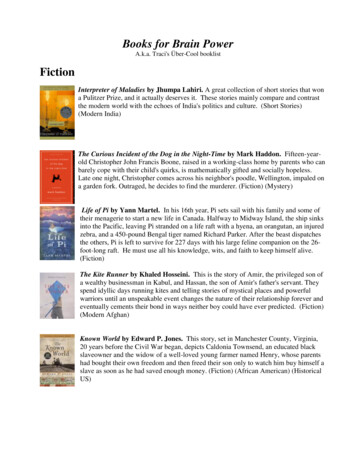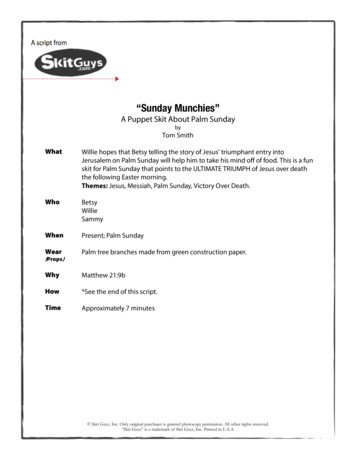
Transcription
Books for Brain PowerA.k.a. Traci's Über-Cool booklistFictionInterpreter of Maladies by Jhumpa Lahiri. A great collection of short stories that wona Pulitzer Prize, and it actually deserves it. These stories mainly compare and contrastthe modern world with the echoes of India's politics and culture. (Short Stories)(Modern India)The Curious Incident of the Dog in the Night-Time by Mark Haddon. Fifteen-yearold Christopher John Francis Boone, raised in a working-class home by parents who canbarely cope with their child's quirks, is mathematically gifted and socially hopeless.Late one night, Christopher comes across his neighbor's poodle, Wellington, impaled ona garden fork. Outraged, he decides to find the murderer. (Fiction) (Mystery)Life of Pi by Yann Martel. In his 16th year, Pi sets sail with his family and some oftheir menagerie to start a new life in Canada. Halfway to Midway Island, the ship sinksinto the Pacific, leaving Pi stranded on a life raft with a hyena, an orangutan, an injuredzebra, and a 450-pound Bengal tiger named Richard Parker. After the beast dispatchesthe others, Pi is left to survive for 227 days with his large feline companion on the 26foot-long raft. He must use all his knowledge, wits, and faith to keep himself alive.(Fiction)The Kite Runner by Khaled Hosseini. This is the story of Amir, the privileged son ofa wealthy businessman in Kabul, and Hassan, the son of Amir's father's servant. Theyspend idyllic days running kites and telling stories of mystical places and powerfulwarriors until an unspeakable event changes the nature of their relationship forever andeventually cements their bond in ways neither boy could have ever predicted. (Fiction)(Modern Afghan)Known World by Edward P. Jones. This story, set in Manchester County, Virginia,20 years before the Civil War began, depicts Caldonia Townsend, an educated blackslaveowner and the widow of a well-loved young farmer named Henry, whose parentshad bought their own freedom and then freed their son only to watch him buy himself aslave as soon as he had saved enough money. (Fiction) (African American) (HistoricalUS)
Alienist by Caleb Carr. Set in New York City in1896, this story depicts a serial killeron the loose, gruesomely preying upon cross-dressing boy prostitutes. Reform-mindedpolice commissioner Theodore Roosevelt, the same T.R. who later became president,is determined to catch the killer. In order to do so, he assembles an unconventionalgroup of investigators headed by "alienist" Dr. Lazlo Kreizler. (Mystery) (HistoricalUS)Their Eyes Were Watching God by Zora Neale Hurston. This is a luminous andhaunting novel about Janie Crawford, a Southern Black woman in the 1930’s, whosejourney from a free-spirited girl to a woman of independence and substance hasinspired writers and readers for close to 70 years. This poetic and graceful love story,rooted in Black folk traditions and steeped in mythic realism, celebrates boldly andbrilliantly African-American culture and heritage. (Fiction) (African American)(Historical US)Native Son by Richard Wright. Bigger Thomas, a 20 year-old black man, isuneducated, unsophisticated, and unemployed. When a wealthy family offers him achauffeur's position, Bigger is torn between gratitude for the job and anger over hissubservient status. On his first evening, the family's daughter orders Bigger to spend adrunken night on the town with her and a gentleman friend. By morning, the youngwoman is dead. (Fiction) (African American)Suite Francais by Irene Nemirovsky. This is a collection of five novels thatchronicle the connecting lives of a disparate clutch of Parisians. The first novel, Stormin June, depicts a snobbish author, a venal banker, a noble priest shepherding churlishorphans, a foppish aesthete, and a loving lower-class couple fleeing city comforts forthe chaotic countryside, mere hours ahead of the advancing Germans. The second,Dolce, set in 1941 in a farming village under German occupation, tells how peasantfarmers, their pretty daughters, and petit bourgeois collaborationists co-existed withtheir Nazi rulers. (Historical France) (Short Stories/Novella) (WWII)Man in the High Castle by Philip K Dick. It's America in 1962. Slavery is legal onceagain. The few Jews who still survive hide under assumed names. In San Francisco, theI Ching is as common as the Yellow Pages. All of the present circumstances have beenset in place because some 20 years earlier the United States lost a war, and NaziGermany and Japan now occupy it jointly. (Science Fiction)Something Wicked This Way Comes by Ray Bradbury. This is a memorable story oftwo boys, James Nightshade and William Halloway, and the evil that grips their smallMidwestern town with the arrival of a "dark carnival" one autumn midnight. Throughintense struggle, these two innocents, both age 13, save the souls of the town as well astheir own. This book is a compelling read based on timeless themes. (Horror) (ScienceFiction) (Fiction)
Name of the Rose by Umberto Eco. In 1327, Brother William of Baskerville arrivesto investigate heresy among the monks in an Italian abbey; however, a series of bizarremurders overshadows the mission. Within the mystery is a tale of books, librarians,patrons, censorship, and the search for truth in a period of tension between the Papacyand the Holy Roman Empire. (Mystery) (Historical Middle Ages Italy)The Lovely Bones by Alice Sebold. When we first meet Susie Salmon, she is alreadyin heaven. Everything she ever wanted appears as soon as she thinks of it, except thething she most wants, to be back with the people she loved on Earth. In the weeksfollowing her death, Susie watches life on Earth continuing without her, school friendstrading rumors about her disappearance, her family holding out hope that she'll befound, and her killer trying to cover his tracks. (Fiction)Ender’s Game by Orson Scott Card. Ender Wiggin is one of a group of childrenbred to be a military genius and save Earth from an inevitable attack by aliens, knownas "buggers." Ender becomes unbeatable in war games and seems poised to lead Earthto triumph over the buggers. Meanwhile, his brother and sister plot to wrest powerfrom Ender. (Science Fiction)Handmaid's Tale by Margaret Atwood. The United States has undergone a nuclearwar, and the government is now a strict and dangerous political scene, where any typeof crime can result in an execution and a public hanging on “The Wall.” Not only that,but women are made secondhand citizens and are no longer able to hold jobs, makemoney, read or write. This story is told through the eyes of Offred, a Handmaid, or asurrogate mother of sorts, who is appointed to an infertile couple in order to getpregnant and help boost the population. (ScienceFiction)(Fiction)Till We Have Faces by C.S. Lewis. This is a tale of two princesses, one beautiful andone unattractive, and the struggle between sacred and profane love. This work isLewis’s re-working of the myth of Cupid and Psyche. (Fiction)Deadly Harvest by Leonard Goldberg. When the sister of forensic pathologistJoanna Blalock needs a liver transplant, Joanna seeks the professional assistance of ahighly acclaimed organization that finds replacement organs. Unfortunately, herinvestigation of the company uncovers the diabolical schemes behind DonorsInternational’s acquisition of the ideal transplants. A conspiracy is un-covered thatwill send shockwaves throughout the medical world. (Mystery)
Thousand Acres by Jane Smiley. Aging Larry Cook announces his intention to turnover his 1,000-acre farm, one of the largest in Zebulon County, Iowa, to his threedaughters, Caroline, Ginny, and Rose. A man of harsh sensibilities, he carves Carolineout of the deal because she has the nerve to be less than enthusiastic about her father'sgenerosity. While Larry Cook deteriorates into a pathetic drunk, his daughters are leftto cope with the often grim realities of life on a family farm, from battering husbandsto cutthroat lenders. (Fiction)T, by Audrey Niffenegger Young lovers often believethemselves crossed by fate or by time, but those in Niffenegger’s spirited first novelhave more reason than most. Henry suffers from Chrono-Impairment—a quasi-medicalcondition that catapults him, unwillingly, from one random point in time to another.Clare first meets him in 1977, when she is six and he materializes near her parents’garden as a thirty-six-year-old from 2000; he returns regularly throughout herchildhood from different times in their shared future. At last, when Clare is twenty andHenry twenty-eight, they meet in his present, and the relationship begins in earnest.But romance proves even trickier than usual when one person keeps vanishing todistant, and occasionally dangerous, times. Niffenegger plays ingeniously in hertemporal hall of mirrors, but fails to make the connection between the lovers ascompelling as their odd predicament. From The New Yorker. (Nonfiction)Confederacy of Dunces by John Kennedy Toole. Meet Ignatius J. Reilly, a 30-yearold medievalist living at home with his mother in New Orleans. Reilly pens hismagnum opus on Big Chief writing pads, which he keeps hidden under his bed, and herelays to anyone who will listen the traumatic experience he once had on a GreyhoundScenicruiser bound for Baton Rouge. However, Ignatius's quiet life of tyrannizing hismother and writing his endless comparative history screeches to a halt when he isalmost arrested by the overeager Patrolman Mancuso who mistakes him for a vagrant.Afterwards, Reilly is then involved in a car accident with his tipsy mother behind thewheel. One thing leads to another, and before he knows it, he needs a (gasp!) job.(Fiction)Bluest Eye by Toni Morrisson. This is the story of the Breedloves, a poor blackfamily living in Lorain, Ohio in the early 1940s. Each chapter tells something different:the journey of the dad, Cholly, from curious young boy to a drunk and unloving father,the history of the mother, Pauline and her dreams of movie stars and romance, and thechildhood of the children, Sammy and Pecola, and how they deal with life as they'vebeen given. ( Fiction) (African American)Out by Natsuo Kirino. This is the story of Yayoi, the youngest and prettiest of fourwomen who work the night shift in a Tokyo factory, who strangles her philanderinggambler husband with his own belt in an explosion of rage. Afterwards, she turnsinstinctively for help to her co-worker Masako, an older and wiser woman whose ownfamily life has fallen apart in less dramatic fashion. To help her cut up and get rid ofthe dead body, Masako recruits Yoshie and Kuniko, two fellow factory workers caughtup in other kinds of domestic traps. (Mystery) (Japan)
Things Fall Apart by Chinua Achebe. This is a relentlessly unsentimental renderingof Nigerian tribal life before and after the coming of colonialism. Achebe sketches aworld in which violence, war, and suffering exist, but are balanced by a strong sense oftradition, ritual, and social coherence. (Fiction) (Nigeria)Yellow Raft in Blue Water by Michael Dorris. Three generations of Native Americanwomen deal with the trials of life and their interactions with each other set against theobscene and the presence of the men in their lives. (Fiction) (Native American)The Master Butchers Singing Club by Louise Erdrich. After German soldier FidelisWaldvogel returns home from World War I to marry his best friend's pregnant widow,he packs up his father's butcher knives and sets sail for America. He settles in Argus,North Dakota, where he sets up a meat shop with his wife Eva, who quickly befriendsthe struggling yet resourceful Delphine Watzka. Delphine, who runs a vaudeville showwith her balancing partner Cyprian Lazarre, has returned home to Argus to care for heralcoholic father. (Fiction) (Native American)The Corner of His Eye by Dean Koontz. The premise behind Koontz's novel is thatthere exist multitudes of alternate universes, each varying only slightly from the next.Every act of good and evil magnifies as they affect others. (Mystery) (Horror)(Science Fiction)Woman in Dunes by Kobo Abe. This is the story of an amateur entomologist whowanders alone into a remote seaside village in pursuit of a rare beetle he wants to addto his collection; however, but the townspeople take him prisoner. They lower him intothe sand-pit home of a young widow, a pariah in the poor community, who thevillagers have condemned to a life of shoveling back the ever-encroaching dunes thatthreaten to bury the town. (Fiction)Me Talk Pretty One Day by David Sedaris. Sedaris's caustic gift has not deserted himin his fourth book, which mines poignant comedy from his peculiar childhood in NorthCarolina, his bizarre career path, and his move with his lover to France. Though hisanarchic inclination to digress is his glory, Sedaris does have a theme in thesereminiscences, the inability of humans to communicate. (Short Stories) (Fiction)(Travel)
Prayer for Owen Meany by John Irving. Owen Meany is a dwarfish boy with astrange voice who accidentally kills his best friend's mom with a baseball and believesthat he is an instrument of God, to be redeemed by martyrdom. (Fiction)Alchemist by Paolo Coelho. Santiago, an Andalusian shepherd, dreams of a distanttreasure in the Egyptian pyramids. He learns about the alchemists, men who believedthat if a metal were heated for many years, it would free itself of all its individualproperties and what was left would be the "Soul of the World." (Fiction)Where the Heart Is by Billie Letts. A funny thing happens to Novalee Nation on herway to Bakersfield, California. Her ne'er-do-well boyfriend, Willie Jack Pickens,abandons her in an Oklahoma Wal-Mart and takes off on his own, leaving her with just10 dollars and the clothes on her back. Not that hard luck is anything new to Novalee,who is "seventeen, seven months pregnant, thirty-seven pounds overweight--andsuperstitious about sevens. (Fiction)Fame (Firstborn Series #1) by Karen Kingsbury Dayne, Hollywood's number onehunk, wants to work opposite someone who exudes innocence in his new romanticcomedy, so he persuades his casting agent to bring an unknown woman fromBloomington, Ind., for an audition—Katy. Katy once aspired to be a famous actress—she filmed a made-for-TV movie—but now she directs a children's theater. Indeed, itwas through the theater that Dayne first discovered Katy: on a trip to Bloomington, shehad captured his attention during a performance. Because this is the first in a plannedfive-volume series, none of the plot lines tie up neatly. By the end, Kingsbury hasrevealed that Dayne has some deep, secret family links to Bloomington; presumablythese connections will be explored in subsequent novels. (Fiction) (Christian)The Yearling by Marjorie Kinnan Rawlings Fighting off a pack of starving wolves,wrestling alligators in the swamp, romping with bear cubs, drawing off the venom of agiant rattlesnake bite with the heart of a fresh-killed deer--it's all in a day's work for theBaxter family of the Florida scrublands. But young Jody Baxter is not content withthese electrifying escapades, or even with the cozy comfort of home with Pa and Ma.He wants a pet, a friend with whom he can share his quiet cogitations and his cornpone. Jody gets his pet, a frisky fawn he calls Flag, but that's not all. With Flag comesa year of life lessons, frolicking times, and achingly hard decisions. (Fiction) (Florida)
The Dew Breaker by Edwidge Danticat spins a series of related stories around ashadowy central figure, a Haitian immigrant to the U.S. who reveals to his artistdaughter that he is not, as she believes, a prison escapee, but a former prison guard,skilled in torture and the other violent control methods of a brutal regime. "Your fatherwas the hunter," he confesses, "he was not the prey." Into this brilliant opening,Danticat tucks the seeds of all that follows: the tales of the prison guard's victims, oftheir families, of those who recognize him decades later on the streets of New York, ofthose who never see him again, but are so haunted that they believe he's still pursuingthem. (A dew breaker, we learn, is a government functionary who comes in the earlymorning to arrest someone or to burn a house down, breaking the dew on the grass thathe crosses.) (Fiction) (Haitian American)The Man Who Smiled by Henning Mankell Depressed and world-weary after havingkilled a man in the line of duty, Detective Kurt Wallander returns from two years ofwallowing in guilt to investigate the murders of a father and son, both prominentlawyers. His investigation takes the brooding Swede into an intricate web of deceptionand horror. (Mystery)Mildred Pierce by James M. Cain Cain's classic novel of a woman scorned whosurvives no-good men and a hateful daughter to make it in 1930s Los Angeles.(Mystery) (Noir)The Things They Carried by Tim O'Brien "They carried all the emotional baggageof men who might die. Grief, terror, love, longing--these were intangibles, but theintangibles had their own mass and specific gravity, they had tangible weight. Theycarried shameful memories. They carried the common secret of cowardice. Menkilled, and died, because they were embarrassed not to." A story told through theletters and equipment hauled through the jungles of Viet Nam, but the story goes waybeyond that. (fiction) (Military) (Viet Nam)House Made of Dawn by Scott Momaday A young Native-American Indian namedAbel, returns to Walatow Reservation in New Mexico from World War II only todiscover that he is caught between two worlds. Momaday combines the struggles ofNative Americans living in industrial America paired with Kiowa legends and history.(Pulitzer Prize Winner) (Fiction) (Native American)
Before Women Had Wings by Connie May Fowler Avocet Jackson, called Bird, liveswith her parents, Billy and Glory Marie, and her older sister, Phoebe, in a roachinfested Florida shack. When Billy, a frustrated country music singer who hassquandered his talent in booze, commits suicide, a desperate Glory Marie takes thegirls to the outskirts of Tampa, where they move into a dilapidated trailer. Terrorizedby her mother's alcohol-fueled rages, Bird is further confused by the fire-andbrimstone strictures of the Bible, which she takes literally. Mixing the squalid detailsof Bird's life with the child's magical dreams of hope and healing, this book graphicallydetails the abuse. (Fiction) (Florida) (Child abuse)Rebecca by Daphne Du Maurier: This riveting tale of fear, suspicion, and love opensas the unnamed narrator reminisces about her former home, the grand English estate,Manderley. She had been young and shy, a lady's companion, when she met thewealthy recent widow, Maxim de Winter, fell in love with him, and married him in amatter of weeks. They returned to his home, where she was immediately overwhelmedwith the responsibilities of running the house and dealing with her forbiddinghousekeeper as well as the memory of Maxim's first wife, Rebecca. She had beenbeautiful, sophisticated, and supremely confident, and the narrator felt lost and helplessin comparison. Her new husband was strangely distant to her, until a horrible secretwas revealed that would change their lives and the very existence of Manderley.(Fiction) (Mystery)The Five People You Meet in Heaven, by Mitch Albom Sports columnist, radio talkshow host, and author of Tuesdays with Morrie, Albom has written a parable quitedifferent from his best-selling memoir about his old professor but with the potential tofollow it as a favorite of the book club circuit. At an oceanside amusement part, 83year-old maintenance mechanic Eddie is killed while trying to save a little girl. Insteadof floating through the cliched tunnel-and-light territory, Eddie meets five peoplewhose lives intersected with his during his time on Earth. The novel comes downfirmly on the side of those who feel that life matters, that what we do as individualsmatters, and that in the end there will be a quiz. The touchy-feely phobic need not beafraid: this is not judgmental ax-grinding; nor does it favor any religion. Before youfinish reading, you can't help thinking about your own life-Albom's whole point, ofcourse. Morrie fans will want to read this first novel, and readers daring to examinetheir own lives may enjoy as well. For all public libraries.-Mary K. Bird-Guilliams,Wichita P.L., KS Copyright 2003 Reed Business Information. From Library Journal.(Inspirational)
The Book Thief by Markus Zusak Australian-born Markus Zusak grew up sitting atthe kitchen table, glued to his chair, listening to his mother's tales of her childhood inNazi Germany. Such tales would later serve as a springboard for his unusual novelabout the power of words to both destroy and comfort. A daring work in theadventurous spirit of The Shadow of the Wind, this novel has a bizarre narrator: Death.Drawn into a tense and dangerous historical era, readers discover how LieselMeminger first learns to read and is transformed into the "book thief," stealing booksbefore they can be burned by the Nazis or confiscated from personal libraries. Whenher family decides to hide a Jew in the basement, Liesel holds out hope to him in theform of her two most precious commodities: words and stories. From Barnes andNoble.Non-FictionReading Lolita in Tehran: A Memoir in Books by Azar Nafisi. A woman's bookclub meets in secret and creates an apt comparison between Iranian political and socialpolicies and classics of literature. (History) (Modern Iran)Night by Elie Wiesel. A scholarly pious teenager is wracked with guilt at havingsurvived the horror of the Holocaust and the genocidal campaign that consumed hisfamily. His memories of the nightmare world of the death camps present him with anintolerable question, “How can the God he once so fervently believed in have allowedthese monstrous events to occur?” (WWII) (Jewish Holocaust) (Germany)The Hot Zone by Richard Preston. This is a dramatic and chilling story of an Ebolavirus outbreak in a suburban Washington, D.C. laboratory with descriptions offrightening historical epidemics of rare and lethal viruses. More hair-raising thananything Hollywood could think of because it's all true. (Medical)Survival of the Sickest by Sharon Moalem. Is there a reason for such afflictions asdiabetes, sickle-cell anemia, and antibiotic-resistant infection? If every living thingdances to the same two-step imperative, survive and reproduce, then even the diseasesour increasingly homogeneous society struggles to conquer, once must have served apurpose. (Medical)
Guns Germs and Steel by Jared Diamond. Jared Diamond argues that the Earth'sgeography has been the sole determining factor in the evolution and development of allthe world's civilizations. (Medical) (Biology) (Geography) (Socio-Economics)Man who Mistook his Wife for a Hat by Oliver Sacks. Sacks explores neurologicaldisorders with a novelist's skill and an appreciation of his patients as human beings.These cases illustrate the tragedy of losing neurological faculties such as: memory,powers of visualization, word-recognition, or the also devastating fate of thosesuffering an excess of neurological functions causing such hyper states as chorea, tics,Tourette's Syndrome, and Parkinsonism. (Medical)Under the Black Flag: The Romance and the Reality of Life Among the Pirates byDavid Cordingly. Though literature, films, and folklore have romanticized pirates asgallant seaman who hunted for treasure in exotic locales, David Cordingly reveals thefacts behind the legends of such outlaws as Captain Kidd, Blackbeard, and Calico Jack.Even stories about buried treasure are fictitious! Pirate captains were often sadisticvillains, and crews endured barbarous tortures. Crews were constantly threatened withthe possibility of death by hanging,drowning in astorm, or surviving a shipwreck on a hostile coast. (History)(Caribbean)We Wish to Inform You That Tomorrow We Will be Killed With Our Families:Stories from Rwanda by Philip Gourevitch. "The best reason I have come up withfor looking more closely into Rwanda's stories is that ignoring them makes me evenmore uncomfortable about existence and my place in it." The stories are unrelentinglyhorrifying and filled with "the idiocy, the waste, the sheer wrongness" of one group ofRwandans (Hutus) methodically exterminating another (Tutsis)-800,000 people killedin 100 days. (History) (Modern Rwanda)Dead Men Do Tell Tales: The Strange and Fascinating Cases of a ForensicAnthropologistby William R. Maples. Noted forensic anthropologist Maples, whose specialty is thestudy of bones, and freelance journalist Browning recount Maples's criminal andanthropological investigations over the past 20 years. The book's strength is that it is asnapshot of the world of forensic scientists, which vividly portrays the siege mentalityof many of them when their objective data is used for purposes other than ascertainingthe truth about how a victim died. (Medical) (True Crime)In Patagonia by Bruce Chatwin. Prompted by a piece of reddish animal skin thatfamily legend says is brontosaurus skin which he found in his grandmother's curiocabinet when he was a child, the author ignites himself on a flight of fancy about itsorigin. This quest leads him to an expansive area of wild beauty and adventure,Patagonia on South America's southernmost tip. (Travel) (History) (Argentina)
Travels with Charlie in Search of America by John Steinbeck. At age 58, JohnSteinbeck and his venerable standard poodle, Charley, set out on a journey acrossAmerica in a camper. For three months, these companions traveled the nation meetingfriends, strangers, and relatives. Throughout their adventure, they immerse themselvesin the fabric of the country as it was at that time.(Travel) (US)In a Sunburned Country by Bill Bryson. Bill Bryson tells the story of his exploits inAustralia, where A-bombs go off unnoticed, prime ministers disappear into the surf,and cheery citizens co-exist with the world's deadliest creatures: toxic caterpillars,aggressive seashells, crocodiles, sharks, snakes, and the deadliest of them all, thedreaded box jellyfish. And that's just the beginning, as Bryson treks through sun-bakeddeserts and up endless coastlines, crisscrossing the "under-discovered" Down Under insearch of all things interesting. (Travel)(Australia)House of Rain: Tracking a Vanished Civilization Across the American Southwest byCraig Childs. Although less well known than the Mayans, the Anasazi, whoflourished in the region now known as New Mexico, also vanished without a trace.Now, eight centuries after their thriving, this 2,000-year-old civilization disappeared asthough it had never existed, naturalist and adventurer Childs undertakes to find outwhere the Anasazi went and why. (Ancient History) (US)Love and Hatred by William Sherer. Occasionally quoting from Tolstoy's novels,Shirer draws on the diaries, letters, and testimony of Leo, Sonya, their children, andassociates for this darkly magnificent dual portrait. (Biography) (Russia)The Rise of the Creative Class by Richard Florida. Florida defines a new class ofindividuals, whose members include scientists, engineers, architects, educators, writers,artists, and entertainers, as those whose economic function is to create new ideas, newtechnology, and new creative content. In general, this group shares commoncharacteristics such as creativity, individuality, diversity, and merit. The authorestimates that this group has 38 million members, constitutes more than 30 percent ofthe U.S. workforce, and profoundly influences work and lifestyle issues.(Business)(Economics)(Social Theory)The Warrior Woman: Memoirs of a Girlhood Among Ghosts by Maxine HongKingston. Split between two worlds, Kingston writes of growing up in Americacoupled with her Chinese heritage. She weaves the stories of the women in her familywith Chinese mythology. (Autobiography) (Chinese American)
Tuesdays with Morrie: an old man, a young man, and life's greatest lesson by MitchAlbom. This true story about the love between a spiritual mentor and his pupilreminds us of the affection and gratitude that many of us still feel for the significantmentors of our past. It also plays out a fantasy many of us have entertained: whatwould it be like to look those people up again, tell them how much they meant to us,and maybe even resume the mentorship? (Biography) (Education)Kitchen Confidential: Adventures in the Culinary Underbelly by AnthonyBourdain. Most diners believe that their sublime sliver of seared foie gras, toppedwith an ethereal buckwheat blini and a drizzle of piquant huckleberry sauce, wascreated by a culinary artist of the highest order, a sensitive highly refined executivechef. The truth is more brutal. It is more likely, writes Anthony Bourdain in KitchenConfidential, that elegant three-star concoction is the collaborative effort of a team of"wacked-out moral degenerates, dope fiends, refugees, a thuggish assortment ofdrunks, sneak thieves, sluts, and psychopaths." Such is the muscular view of theculinary trenches from one who has been groveling in them, with obvious sadomasochistic pleasure for more than 20 years. (Food) (Biography)On Her Own Ground: The Life and Times of Madam C.J. Walker by A'LeliaBundles. The daughter of slaves, C.J. Walker (1867-1919) was married at 14 andbecame a widow with a baby daughter at 20. But by the time she was 40, Walker wasthe first female African American millionaire, thanks to her popular hair-care productsfor black women and her brilliance at marketing them. (US History) (AfricanAmerican) (Business) (Biography)Kon Tiki by Thor Heyerdahl. Kon-Tiki is the record of an astonishing adventure, ajourney of 4,300 nautical miles across the Pacific Ocean by raft. Intrigued byPolynesian folklore, biologist Thor Heyerdahl suspected that the South Sea Islands hadbeen settled by an ancient race from thousands of miles to the east,
The Lovely Bones by Alice Sebold. When we first meet Susie Salmon, she is already in heaven. Everything she ever wanted appears as soon as she thinks of it, except the thing she most wants, to be back with the people she loved on Earth. In the weeks following her death, Susie wat











